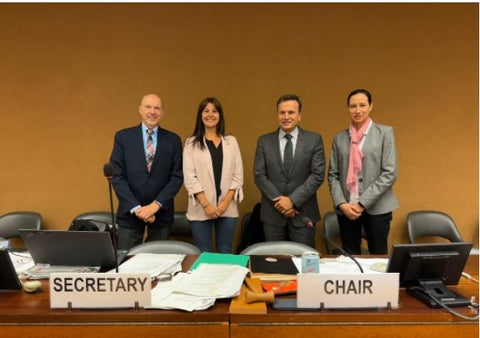KEY NEWS 1/4 — European Union
New Provisional Agreement amending Regulation (EU) 2019/1242 as regards strengthening the CO₂ emission performance standards for new heavy-duty vehicles and integrating reporting obligations
During January 2024, the Council and the European Parliament’s negotiators reached a provisional political agreement on CO2 emission standards for heavy-duty vehicles (HDVs). The aim is to further reduce CO2 emissions in the road transport sector and to introduce new targets for 2030, 2035 and 2040. The new rules will contribute to fulfilling the EU’s 2030 climate ambitions and reaching climate neutrality by 2050.
The proposal also aims to encourage an increasing share of zero-emission vehicles (ZEVs) in the EU-wide heavy-duty vehicle fleet, while ensuring that innovation in the sector and its competitiveness are preserved and enhanced.

The deal includes changes in the following main points:
- The scope of the Regulation is expanded to make almost all new heavy-duty vehicles with certified CO2emissions – including smaller trucks, urban buses, coaches, and trailers – subject to emission reduction targets.
- New emission reduction targets: In line with the EU’s climate objectives for 2030 and beyond, the Council and Parliament maintained the targets set by the Commission in its proposal for 2030 (45%), 2035 (65%), and 2040 (90%), in addition to the 2025 reduction target of 15% which was already provided for in the current regulation. These targets will apply to heavy trucks over 7.5t and coaches.
- Zero-emission target for urban buses. The proposed amendment introduces a 100% zero-emission target for urban buses by 2035, while setting an intermediate target of 90% for this category by 2030.
The provisional agreement will now be submitted to the member states’ representatives within the Council and to the Parliament’s environment committee for endorsement. If approved, the text will then need to be formally adopted by both institutions, following revision by lawyer-linguists, before it can be published in the EU’s Official Journal and enter into force.
KEY NEWS 2/4 — European Union
New rules to minimize emissions from powerful greenhouse gases
During January 2024, the European Parliament approved new rules to minimize emissions from powerful greenhouse gases, in line with EU and global climate goals. The adopted proposal for new Regulation of the European Parliament and of the Council on fluorinated greenhouse gases, amending Directive (EU) 2019/1937 and repealing Regulation (EU) No 517/2014 foresees a total phase-out of hydrofluorocarbons (HFCs) by 2050, including a trajectory to reduce the EU consumption quota between 2024-2049.

The adopted proposal introduces strict requirements that prohibit placing on the EU market products containing F-gases and specific phase-out dates for the use of F-gases in sectors where it is technologically and economically feasible to switch to alternatives that do not use F-gases, such as domestic refrigeration, air conditioning and heat pumps.
This proposal was initiated on 5 April 2022 when the Commission made a legislative proposal to update Regulation (EU) 517/2014. The Commission proposed to align the Fluorinated Gas (F-gas) Regulation with:
- The European Green Deal and the European Climate Law;
- Recent international obligations on HFCs under the Montreal Protocol;
- International progress made.
Following the final votes in plenary, the Council will now have to formally endorse the texts before their publication in the EU Official Journal.
KEY NEWS 3/4 — USA
E-Cert: Electronic application submittal system—Notice and Request for Comment

The California Air Resources Board (CARB) has introduced the E-Cert, an electronic application submittal system. E-Cert loads files and allows CARB staff to review applications. Manufacturers receive an electronic notification when their application has been loaded into E-Cert.
The Light-Duty Vehicle (LDV) module of the E-Cert system is currently undergoing some modifications to accommodate the new requirements for Advanced Clean Cars II, as well as add new data fields critical to the current program. As a result, CARB has made updates to the data requirements, InfoPath Form, and XML schema.
This notice made by CARB serves as an announcement that documents are posted on the E-Cert website. Manufacturers will have to implement these changes to their systems by 1 September 2024, tentatively, when the modified E-Cert system will begin accepting and processing LDV certification applications for 2026 model year vehicles.
KEY NEWS 4/4 — UNECE
191st session of the WP.29: List of adopted proposals
The World Forum for Harmonization of Vehicle Regulations (WP.29) held its 191st session on 14-16 November 2023.
They voted and adopted several proposals for amendments and corrigenda to existing UN Regulations. The estimated date of entry into force is June 2024-
Among these amendments, the following should be highlighted:
- New 06 series to the IWVTA Regulation New 09 series to UN R.016
- New 01 series to UN 145 about ISOFIX anchorage systems, ISOFIX top tether anchorages and i-Size
- New UN Regulation 169 about Event Data Recorders for Heavy Duty Vehicles
- New UN Regulation 170 about Child Restraint Systems for Safer Transport of Children in Buses
UN R.170: Child Restraint Systems for Safer Transport of Children in Buses
This Regulation lays down the technical and administrative requirements that three-point restraint systems in coaches must meet in order to improve child restraint in the event of an accident.
However, it is crucial to note that if the vehicle seat is designated for adult use as well, it must adhere to UN Regulation No. 14 and UN Regulation No. 80, or UN Regulation No. 17 if applicable, alongside the safety-belt anchorages.
Applus+ IDIADA's Technical leader expert in Passive Safety Systems Homologations, Marta Anglès, has led an international working subgroup of the United Nations that has developed the proposal for this UN Regulation to improve the safety of child restraint systems in buses and coaches.

The scope of this regulation extends to Built-in Child Restraint Systems fitted in vehicles falling under categories M2 and M3 class B and class III. These systems are designed to secure children ranging from 40 to 150 cm in both forward-facing and rearward-facing vehicle seats.
At a later stage, it is planned to extend the scope of this Regulation to incorporate the requirements to be met by two-point restraint systems as well. This second phase, given the success of the first, will also be led by Marta Anglès.
UN R.169: Event Data Recorders for Heavy-Duty Vehicles
This regulation aims to establish standardized provisions for approving Event Data Recorders (EDRs) in motor vehicles categorized as M2, M3, N2, and N3.
The provisions specify minimum requirements for collecting, storing, and ensuring crash survivability of vehicle crash event data. They do not cover specifications for data retrieval tools and methods, which are subject to national or regional requirements.

The purpose of these provisions is to ensure that EDRs capture crash-related data effectively, aiding crash investigations and safety equipment analysis while minimizing recording of unrelated data. This crash data will enhance understanding of crash circumstances and facilitate the development of safer vehicle designs. The regulation acknowledges that achieving these objectives requires recording data within specified time periods based on defined triggers and thresholds, which may not always immediately precede, follow, or coincide with the crash. This regulation applies to the approval of vehicles categorized as M2, M3, N2, and N3 regarding their EDRs.
New content available in the IRIS Knowledge Base
|
No |
Subject of the Regulation |
Amendment level |
Vehicle categories |
Application date |
|
UN R. 169 |
Event Data Recorders for Heavy- Duty Vehicles |
ADOPTED PROPOSALS |
N2,M2,N3,M3 |
TBD |
|
UN R.170 |
Child Restraint Systems for Safer Transport of Children in Buses and Coaches |
ADOPTED PROPOSALS |
M2, M3 |
TBD |
|
S.I. 2023/1394 |
The Vehicle Emissions Trading Schemes Order 2023 |
IN FORCE |
M and N |
3-January-2024 |
|
S.I. 2023/1257 |
The Car, Van and Heavy Duty Vehicle Carbon Dioxide Emissions Performance Standards (Civil Penalties and Miscellaneous Amendments) Regulations 2023 |
IN FORCE |
M,N and O |
1-January-2024 |
|
GB/T 9254.1- 2021 |
Information technology equipment, multimedia equipment and receivers - Electromagnetic compatibility - Part 1: Emission requirements |
IN FORCE |
M and N |
1-July-2022 |
|
ADR 113 |
Acoustic Vehicle Alerting Systems for Quiet Road Transport Vehicles |
IN FORCE |
M and N |
22-January-2024 |
You can get more information related to these highlights in our Regulatory Monitoring Reports Service.
If you have any questions, please do not hesitate to contact us at iris@idiada.com.

